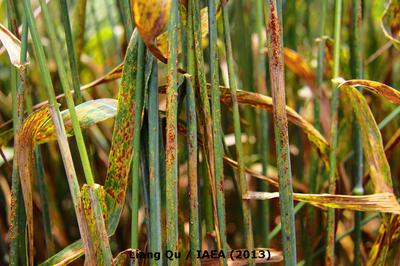Wheat Stem Rust
Puccinia graminis
Jamur
Ringkasan
- Reddish, oval and powdery pustules appear on stems, leaf sheaths and occasionally on leaves.
- The pustules grow and coalesce to cover large areas, giving the plant epidermis a rough appearance.
- Stems can be weakened and plants fall over in heavy winds and rain.
- Weakened plants are prone to infections by other pathogens.
- Yield losses can be serious if the disease becomes servere before the grain is completely filled.
Dapat juga ditemukan di
Gejala
The first symptoms occur 7 to 15 days after infection. Reddish-brown, oval to elongated pustules break out of stems, leaf sheaths, leaves and occasionally on inflorescences. Stems and leaf sheaths are mainly affected. The powdery pustules grow and often coalesce to cover large areas. The resulting damage to the plant epidermis gives the affected parts a rough appearance. If the infection is severe, stems can be weakened and plants buckle or fall over in heavy winds and rain. The fungus hinders water and nutrient transport and causes water loss, reduced plant vigor and reduced nutrient transport to the grain. The grains are shriveled, resulting in reduced yield. The whole plant is weakened, making the risk of an infection with other pathogens high. Yield losses can be serious if the disease is well developed before the grain is completely filled.
Rekomendasi

Pengendalian hayati
Sorry, we don't know of any alternative treatment against Puccinia triticina . Please get in touch with us in case you know of something that might help to fight this disease. We are looking forward to hearing from you.

Pengendalian kimiawi
Always consider an integrated approach with preventive measures together with biological treatments if available. Fungicides containing tebuconazole or prothioconazole can be used to control the fungi. For preventive treatment, fungicides containing triazoles and strobilurins can be applied. Some degree of resistance has been observed with strobilurins.
Apa penyebabnya?
The symptoms are caused by the fungus Puccinia graminis, which is an obligate parasite that needs living plant tissue to survive. Spores can be dispersed over great distances by the wind and germinate when in contact with free water. Other means of dispersion are machinery and vehicles, tools, clothing and footwear. The fungus infects the plant through natural pores on the leaf surface, a process that is favored by low light intensity (early morning or late afternoon) and prolonged leaf wetness caused by frequent dews or rains. Stem rust is also favored by hot days (25-30°C) and mild nights (15-20°C) conducive to the formation of dew. The disease is generally confined to wheat, but other plants can act as vectors or be affected too (other cereals, grasses and species of Berberis shrubs).
Tindakan Pencegahan
- Use disease-resistant wheat varieties.
- Use varieties which mature early.
- Plant as early as possible in the spring.
- Plant as late as possible during the autumn to avoid adverse conditions.
- Monitor fields regularly for any sign of the disease.
- Remove weeds, volunteer plants and species of Berberis shrubs growing in the area.
- Avoid excessive nitrogen fertilization.
- Keep sufficient space between plants to ensure a good ventilation of the plants.
- Remove and destroy all plant residues to prevent survival of the fungus in field.
- Thoroughly clean tools, footwear, hands and trousers before entering another field.



